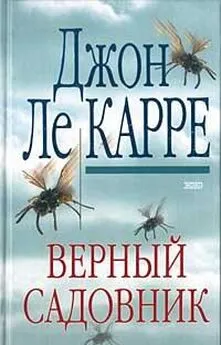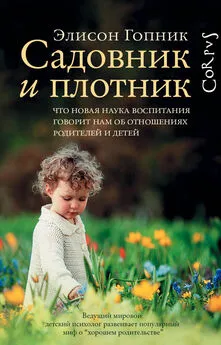Элисон Гопник - Садовник и плотник [litres]
- Название:Садовник и плотник [litres]
- Автор:
- Жанр:
- Издательство:Литагент Corpus
- Год:2019
- Город:Москва
- ISBN:978-5-17-101296-0
- Рейтинг:
- Избранное:Добавить в избранное
-
Отзывы:
-
Ваша оценка:
Элисон Гопник - Садовник и плотник [litres] краткое содержание
Садовник и плотник [litres] - читать онлайн бесплатно ознакомительный отрывок
Интервал:
Закладка:
Cohen, Leslie J., and Joseph J. Campos. “Father, Mother, and Stranger as Elicitors of Attachment Behaviors in Infancy.” Developmental Psychology 10, no. 1 (1974): 146–154. doi: 10.1037/h0035559.
Cook, Claire, Noah D. Goodman, and Laura E. Schulz. “Where Science Starts: Spontaneous Experiments in Preschoolers’ Exploratory Play.” Cognition 120, no. 3 (2011): 341–349. doi: 10.1016/j.cognition.2011.03.003.
Correa-Chávez, Maricela, and Barbara Rogoff. “Children’s Attention to Interactions Directed to Others: Guatemalan Mayan and European American Patterns.” Developmental Psychology 45, no. 3 (2009): 630–641. doi: 10.1037/a0014144.
Corriveau, Kathleen H., Maria Fusaro, and Paul L. Harris. “Going with the Flow: Preschoolers Prefer Nondissenters as Informants.” Psychological Science 20, no. 3 (2009): 372–377. doi: 10.1111/j.1467–9280.2009.02291.x.
Corriveau, Kathleen H., and Paul L. Harris. “Preschoolers (Sometimes) Defer to the Majority in Making Simple Perceptual Judgments.” Developmental Psychology 46, no. 2 (2010): 435–437. doi: 10.1037/a0017553.
Corriveau, Kathleen H., Paul L. Harris, Elizabeth Meins, Charles Fernyhough, Bronia Arnott, Lorna Elliott, Beth Liddle, Alexandra Hearn, Lucia Vittorini, and Marc De Rosnay. “Young Children’s Trust in Their Mother’s Claims: Longitudinal Links with Attachment Security in Infancy.” Child Development 80, no. 3 (2009): 750–761. doi: 10.1111/j.1467–8624.2009.01295.x.
Corriveau, Kathleen H., Kerstin Meints, and Paul L. Harris. “Early Tracking of Informant Accuracy and Inaccuracy.” British Journal of Developmental Psychology 27, no. 2 (2009): 331–342. doi: 10.1348/026151008X310229.
Cragg, Brian G. “The Density of Synapses and Neurons in Normal, Mentally Defective and Ageing Human Brains.” Brain 98, no. 1 (1975): 81–90.
Çukur, Tolga, Shinji Nishimoto, Alexander G. Huth, and Jack L. Gallant. “Attention During Natural Vision Warps Semantic Representation Across the Human Brain.” Nature Neuroscience 16, no. 6 (2013): 763–770. doi: 10.1038/nn.3381.
Dahl, Ronald E. “Adolescent Brain Development: A Period of Vulnerabilities and Opportunities. Keynote Address.” Annals of the New York Academy of Sciences 1021, no. 1 (2004): 1–22. doi: 10.1196/annals.1308.001.
Davidson, Natalie S., and Susan A. Gelman. “Inductions from Novel Categories: The Role of Language and Conceptual Structure.” Cognitive Development 5, no. 2 (1990): 151–176. doi: 10.1016/0885–2014 (90) 90024-N.
Davis, Edith A. “The Form and Function of Children’s Questions.” Child Development 3, no. 1 (1932): 57–74. doi: 10.2307/1125754.
De Dreu, Carsten K. W., Lindred L. Greer, Gerben A. Van Kleef, Shaul Shalvi, and Michel J. J. Handgraaf. “Oxytocin Promotes Human Ethnocentrism.” Proceedings of the National Academy of Sciences 108, no. 4 (2011): 1262–1266. doi: 10.1073/pnas.1015316108.
Dehaene, Stanislas. Reading in the Brain: The New Science of How We Read . New York: Penguin, 2009.
DeNavas-Walt, Carmen, Bernadette D. Proctor, and Jessica C. Smith. U. S. Census Bureau, Current Population Reports , 60–239 , Income, Poverty, and Health Insurance Coverage in the United States: 2010. Washington, D. C.: U. S. Government Printing Office, 2011.
DeVries, Rheta. “Games with Rules.” In Play from Birth to Twelve and Beyond: Contexts, Perspectives, and Meanings, edited by Doris Pronin Fromberg and Doris Bergen, 409–415. New York and London: Garland Publishing, 1998.
De Waal, Frans B. M. “Putting the Altruism Back into Altruism: The Evolution of Empathy.” Annual Review of Psychology 59 (2008): 279–300. doi: 10.1146/annurev.psych.59.103006.093625.
Diamond, Marian Cleeves. Enriching Heredity: The Impact of the Environment on the Anatomy of the Brain . New York: Free Press, 1988.
Diamond, Marian, and Janet Hopson. Magic Trees of the Mind: How to Nurture Your Child’s Intelligence, Creativity, and Healthy Emotions from Birth Through Adolescence . New York: Penguin, 1999.
Dixson, Alan. Primate Sexuality: Comparative Studies of the Prosimians, Monkeys, Apes, and Human Beings. Oxford: Oxford University Press, 1998.
Donaldson, Zoe R., and Larry J. Young. “Oxytocin, Vasopressin, and the Neurogenetics of Sociality.” Science 322, no. 5903 (2008): 900–904. doi: 10.1126/science.1158668.
Dunbar, Robin I. M. “Coevolution of Neocortical Size, Group Size and Language in Humans.” Behavioral and Brain Sciences 16, no. 4 (1993): 681–694. doi: 10.1017/S0140525X00032325.
Dye, Matthew W. G., C. Shawn Green, and Daphne Bavelier. “Increasing Speed of Processing with Action Video Games.” Current Directions in Psychological Science 18, no. 6 (2009): 321–326. doi: 10.1111/j.1467–8721.2009.01660.x.
Ebstein, Richard P., Olga Novick, Roberto Umansky, Beatrice Priel, Yamima Osher, Darren Blaine, Estelle R. Bennett, Lubov Nemanov, Miri Katz, and Robert H. Belmaker. “Dopamine D4 Receptor (D4DR) Exon III Polymorphism Associated with the Human Personality Trait of Novelty Seeking.” Nature Genetics 12, no. 1 (1996): 78–80. doi: 10.1038/ng0196–78.
Eisenberg, Dan T. A., Benjamin Campbell, Peter B. Gray, and Michael D. Sorenson. “Dopamine Receptor Genetic Polymorphisms and Body Composition in Undernourished Pastoralists: An Exploration of Nutrition Indices Among Nomadic and Recently Settled Ariaal Men of Northern Kenya.” BMC Evolutionary Biology 8, no. 173 (2008). doi: 10.1186/1471-2148-8-173.
Ellis, Bruce J., and David F. Bjorklund. “Beyond Mental Health: An Evolutionary Analysis of Development Under Risky and Supportive Environmental Conditions: An Introduction to the Special Section.” Developmental Psychology 48, no. 3 (2012): 591–597. doi: 10.1037/a0027651.
Ellis, Bruce J., Marco Del Giudice, Thomas J. Dishion, Aurelio José Figueredo, Peter Gray, Vladas Griskevicius, Patricia H. Hawley, et al. “The Evolutionary Basis of Risky Adolescent Behavior: Implications for Science, Policy, and Practice.” Developmental Psychology 48, no. 3 (2012): 598–623. doi: 10.1037 /0026220.
Estes, David, Henry M. Wellman, and Jacqueline D. Woolley. “Children’s Understanding of Mental Phenomena.” In Advances in Child Development and Behavior 22, edited by Hayne W. Reese, 41–89. San Diego: Academic Press, 1989.
Feldman, Ruth, Ilanit Gordon, Inna Schneiderman, Omri Weisman, and Orna Zagoory-Sharon. “Natural Variations in Maternal and Paternal Care Are Associated with Systematic Changes in Oxytocin Following Parent – Infant Contact.” Psychoneuroendocrinology 35, no. 8 (2010): 1133–1141. doi: 10.1016/j.psyneuen.2010.01.013.
Fisher, Helen. Anatomy of Love: The Natural History of Monogamy, Adultery and Divorce . New York: W. W. Norton and Co., 1992.
Fisher, Helen. Why We Love: The Nature and Chemistry of Romantic Love . New York: Henry Holt and Company, 2004. [Рус. изд.: Хелен Фишер. Почему мы любим: природа и химия романтической любви. Пер. с англ. Е. И. Милицкой. М.: Альпина нон-фикшн, 2012.]
Fisher, Kelly R., Kathy Hirsh-Pasek, Nora Newcombe, and Roberta M. Golinkoff. “Taking Shape: Supporting Preschoolers’ Acquisition of Geometric Knowledge Through Guided Play.” Child Development 84, no. 6 (2013): 1872–1878. doi: 10.1111/cdev.12091.
Fletcher, Garth J. O., Jeffry A. Simpson, Lorne Campbell, and Nickola C. Overall. “Pair-Bonding, Romantic Love, and Evolution: The Curious Case of Homo sapiens .” Perspectives on Psychological Science 10, no. 1 (2015): 20–36. doi: 10.1177/1745691614561683.
Flynn, James R. “Massive IQ Gains in 14 Nations: What IQ Tests Really Measure.” Psychological Bulletin 101, no. 2 (1987): 171–191. doi: 10.1037/0033–2909.101.2.171.
Flynn, James R. What Is Intelligence? Beyond the Flynn Effect . New York: Cambridge University Press, 2007.
Frank, Robert H. Passion Within Reason: The Strategic Role of the Emotions. New York: W. W. Norton and Co., 1988.
Frankenhuis, Willem E., Karthik Panchanathan, and Jay Belsky. “A Mathematical Model of the Evolution of Individual Differences in Developmental Plasticity Arising Through Parental Bet-hedging.” Developmental Science (2015). doi: 10.1111/desc.12309.
Frazier, Brandy N., Susan A. Gelman, and Henry M. Wellman. “Preschoolers’ Search for Explanatory Information Within Adult – Child Conversation.” Child Development 80, no. 6 (2009): 1592–1611. doi: 10.1111/j.1467–8624.2009.01356.x.
Gardner, Howard. The Unschooled Mind: How Children Think and How Schools Should Teach . New York: Basic Books, 2011.
Gardner, Margo, and Laurence Steinberg. “Peer Influence on Risk Taking, Risk Preference, and Risky Decision Making in Adolescence and Adulthood: An Experimental Study.” Developmental Psychology 41, no. 4 (2005): 625–635. doi: 10.1037/0012–1649.41.4.625.
Gaskins, Suzanne. “Children’s Daily Lives in a Mayan Village: A Case Study of Culturally Constructed Roles and Activities.” In Children’s Engagement in the World: Sociocultural Perspectives , edited by Artin Göncü, 25–60. Cambridge: Cambridge University Press, 1999.
Gavrilets, Sergey. “Human Origins and the Transition from Promiscuity to Pair-Bonding.” Proceedings of the National Academy of Sciences 109, no. 25 (2012): 9923–9928. doi: 10.1073/pnas.1200717109.
Gelman, Susan A. The Essential Child: Origins of Essentialism in Everyday Thought . New York: Oxford University Press, 2003.
Gelman, Susan A. “Psychological Essentialism in Children.” Trends in Cognitive Sciences 8, no. 9 (2004): 404–409. doi: 10.1016/j.tics.2004.07.001.
Gelman, Susan A., Peggy J. Goetz, Barbara W. Sarnecka, and Jonathan Flukes. “Generic Language in Parent-Child Conversations.” Language Learning and Development 4, no. 1 (2008): 1–31. doi: 10.1080/15475440701542625.042.
Gelman, Susan A., and Gail D. Heyman. “Carrot-Eaters and Creature-Believers: The Effects of Lexicalization on Children’s Inferences About Social Categories.” Psychological Science 10, no. 6 (1999): 489–493. doi: 10.1111/1467–9280.00194.
Gelman, Susan A., and Lawrence A. Hirschfeld. “How Biological Is Essentialism.” In Folkbiology , edited by Douglas L. Medin and Scott Atran, 403–446. Cambridge, Mass.: MIT Press, 1999.
Gelman, Susan A., Michelle Hollander, Jon Star, and Gail D. Heyman. “The Role of Language in the Construction of Kinds.” In The Psychology of Learning and Motivation: Advances in Research and Theory , edited by Douglas L. Medin, 201–263. San Diego: Academic Press, 2000.
Gelman, Susan A., Sarah-Jane Leslie, Alexandra M. Was, and Christina M. Koch. “Children’s Interpretations of General Quantifiers, Specific Quantifiers and Generics.” Language, Cognition and Neuroscience 30, no. 4 (2015): 448–461. doi: 10.1080/23273798.2014.931591.
Gelman, Susan A., and Ellen M. Markman. “Categories and Induction in Young Children.” Cognition 23, no. 3 (1986): 183–209. doi: 10.1016/0010–0277 (86) 90034-X.
Gelman, Susan A., Marianne G. Taylor, Simone P. Nguyen, Campbell Leaper, and Rebecca S. Bigler. “Mother-Child Conversations About Gender: Understanding the Acquisition of Essentialist Beliefs.” Monographs of the Society for Research in Child Development (2004): i – 142. doi: 10.1111/j.1540–5834.2004.06901002.x.
Читать дальшеИнтервал:
Закладка:
![Обложка книги Элисон Гопник - Садовник и плотник [litres]](/books/1082744/elison-gopnik-sadovnik-i-plotnik-litres.webp)



![Элисон Диксон - Другая миссис Миллер [litres]](/books/1058289/elison-dikson-drugaya-missis-miller-litres.webp)


![Элисон Уэйр - Джейн Сеймур. Королева во власти призраков [litres]](/books/1074967/elison-uejr-dzhejn-sejmur-koroleva-vo-vlasti-prizr.webp)
![Элисон Робертс - Невероятная случайность бытия [Эволюция и рождение человека] [litres]](/books/1080754/elison-roberts-neveroyatnaya-sluchajnost-bytiya-evol.webp)
![Элисон Блэк - Особенные. Путь к совершенству [СИ]](/books/1092172/elison-blek-osobennye-put-k-sovershenstvu-si.webp)
